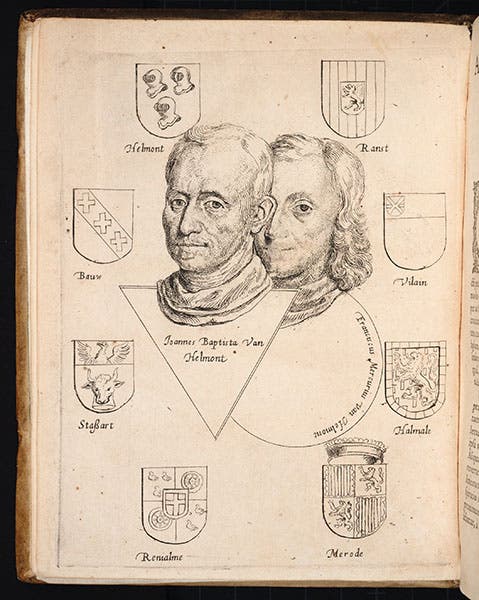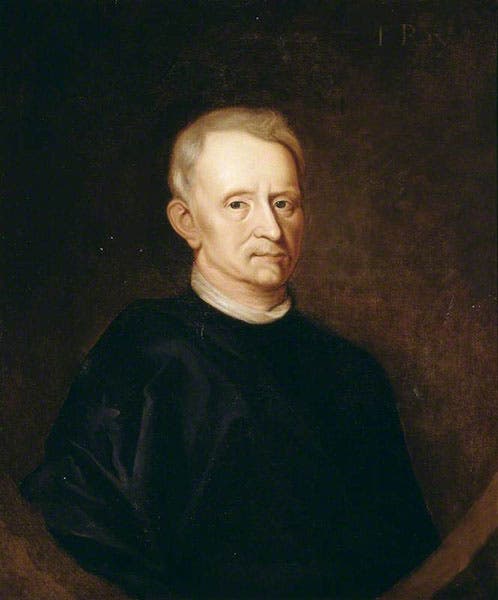Scientist of the Day - Joan Baptista van Helmont
Joan Baptista van Helmont, a Flemish physician, was born Jan. 12, 1579. Van Helmont (alternatively referred to as Jan Baptist van Helmont) was a strong proponent for what was called, in his day, iatrochemistry, or medical chemistry. Medicine since the time of Galen in ancient Greece had relied almost exclusively on plant preparations as remedies for illness, until Paracelsus in the 16th century had rebelled against what he called the Galenic tyranny and argued that disease has a chemical origin. Van Helmont agreed, and thus van Helmont was, in this sense anyway, a Paracelsian. Van Helmont is notable in the history of chemistry for being the first to identify “airs” that are different from the air we breathe. He pointed out the peculiar properties of the "air" given off during wine-making, and combustion, calling it "gas sylvestre", and he recognized another "air" that accumulates in swamps and the intestines, which he called "gas pingue". These two gases will later be identified as carbon dioxide and methane. The very word "gas" was a Helmontian invention, derived from the Greek word "chaos".
Van Helmont is also known for an experiment in which he planted a willow sapling in a tub of earth and allowed it to grow into a modest 160-pound tree. He watered the tree regularly, and weighed the earth in the tub before and after; since the amount of dirt remained almost unchanged, he concluded that the substance of the tree must have come from the water and not the earth. The fame of the experiment comes not from the results, but from the fact that it was quantitative, in an age when it was not generally realized that measurement was the best way to understand nature, whether you were growing trees in tubs or rolling balls down planes to determine their rate of acceleration. Interestingly, except for Robert Boyle, no one seems to have attached any importance to the willow-tree experiment until the 20th century. I have searched for years and have never found an illustration of the experiment that predates modern times. Even the indefatigable Louis Figuier, in his Les Merveilles de la science (1867-91), on which we have relied many times in these posts for illustrations, did not include a wood engraving of the willow-tree experiment.
Focusing on gases and the tree experiment, as we have so far, makes van Helmont seem like a rather modern scientist. In fact, he was a mystic, and his world view was filled with spirits and vital presences and sympathies. Indeed, early in his career, his belief in sympathetic cures – that one could treat a wound by manipulating the weapon that caused the wound – ran him afoul of both medical and theological authorities in Louvain. It did not help his career that he also detested the Jesuits and what he considered their casuist approach to scientific questions. From 1621, when his treatise on the weapon salve was published (by his enemies), until 1642, van Helmont was under formal investigation by ecclesiastical authorities, and for most of that time he was under house arrest, forbidden to travel or publish any of his writings. But he did prepare a collection of treatises for publication, and four years after his death (in 1644), his son, Franciscus Mercurius van Helmont, issued this collection as Ortus medicinae (The Rise of Medicine, 1648; second image). We have this work in our History of Science Collection. It contains a frontispiece portrait of father and son (first and third images) that provides us with our only contemporary glimpse of the visage of this enigmatic late Renaissance iatrochemist. All other portraits, including a handsome oil painting by Mary Beale in the Natural History Museum in London, stem from the 1648 engraving (fourth image).
Franciscus Mercurius, himself a prominent figure in the Netherlands, later published a more complete edition of his father’s works in 1682 (which we also have in the collection) and a German translation of the works in 1683 (which we do not).
There is a memorial statue of van Helmont in Brussels (fifth image), designed by someone who evidently paid no attention to any of the portraits.
Dr. William B. Ashworth, Jr., Consultant for the History of Science, Linda Hall Library and Associate Professor emeritus, Department of History, University of Missouri-Kansas City. Comments or corrections are welcome; please direct to ashworthw@umkc.edu.










